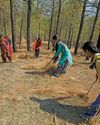
IN FEBRUARY, officials from the Dharmapuri forest division in Tamil Nadu captured a 145-year-old elephant and translocated it to the Anamalai Tiger Reserve. The tuskless male elephant was blamed for causing extensive damage to crops in the surrounding villages. However, it soon started marching towards its home range, covering some 100 km in just two days. The forest officials then tranquilised and captured the elephant again. They radio collared the elephant and decided to release it in a nearby forest. But wherever they took it, local communities opposed its release. Finally, after travelling 200 km in a truck over an agonising 24 hours, the animal was released deep inside a a reserved forest in Manombally-Varakaliyar. It was last seen on February 24, drinking water in its new territory.
In geographies where elephants are found, translocation is being increasingly employed as a tool to mitigate conflicts between humans and the animal. With mobile phones and CCTV cameras, it has become easier for people to capture visuals of elephants in farmlands or frequenting the vicinity of human settlements. And when conflicts arise, such images of elephants are shared, and their removal is demanded. "The only solution locals seek is removing the animal from the area. Often, males are captured and matriarchs are radio-collared," says a Karnataka forest department official.
This story is from the {{IssueName}} edition of {{MagazineName}}.
Start your 7-day Magzter GOLD free trial to access thousands of curated premium stories, and 9,000+ magazines and newspapers.
Already a subscriber ? Sign In
This story is from the {{IssueName}} edition of {{MagazineName}}.
Start your 7-day Magzter GOLD free trial to access thousands of curated premium stories, and 9,000+ magazines and newspapers.
Already a subscriber? Sign In

THE CIRCULARITY ARGUMENT
A circular economy can help India achieve its developmental aspirations while following the low-carbon pathway. It will also help address the challenges of waste management, pollution and overexploitation of natural resources. Industries are already innovating to reuse high-volume wastes and have shown that the transition can usher in both environmental and financial windfalls

Banking on flawed drug voluntary licences
The Medicines Patent Pool is pushing for more VLs, but its bad deal with Novartis on a cancer drug shows the pitfalls

Lasting solutions
For the first time, the UN has recognised the role of indigenous communities in tackling aridity. A repository of traditional knowledge India has the wherewithal to lead the way

IMD at 150
India's journey into modern weather forecasting took a decisive turn 150 years ago with the establishment of India Meteorological Department during the British rule. The agency has come a long way since then, shaping the way the country predicts and responds to its diverse climate challenges

Every drop counts
In drought-prone Marathwada region, 14 villages have managed to counter water shortage by budgeting the resource

Threat to survival
Hollongapar Gibbon Sanctuary in Assam faces ecological challenges as railway electrification and hydrocarbon exploration endanger its fragile biodiversity

'Migration is going to be a battlefield'
AMITAV GHOSH is one of the foremost chroniclers of our times. His literary sojourn includes writings on topics that range from languages to climate change to human lives. His latest book, Wild Fictions, brings some of his works on these issues under one title. In a conversation with RAJAT GHAI, Ghosh shares his views on the future of human movement. Excerpts:

Face of future
California wildfires confirm forest fires are intensifying in a hotter world, emitting substantial amounts of greenhouse gases and reinforcing global warming

Friends of the forest
Residents of 30 villages in Uttarakhand establish a model for public participation in saving forests from wildfires

Climate-crazy playbook
Just hours after his second (and final) term began on January 20, US President Donald Trump unleashed 46 presidential actions. Several of these are centred on the US' climate commitments, energy transition, migration and trade policies, and are likely to have negative global implications